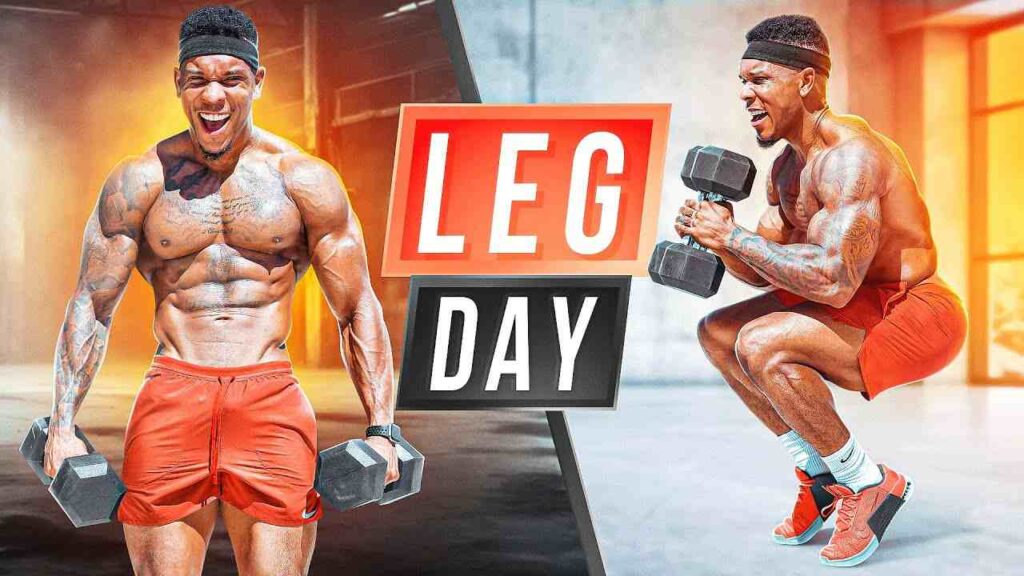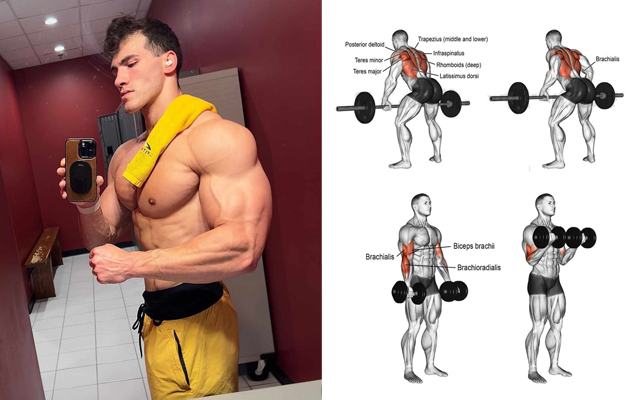Strong, well-defined back muscles don’t just add an impressive visual element to your physique. They’re also crucial for maintaining good posture, ensuring proper body alignment, and reducing the risk of injury. One of the most effective tools for building these muscles is something you’ll find in almost every gym — the humble dumbbell.
Dumbbells offer a high degree of motion freedom, allowing you to target different muscle groups and work them from various angles. This versatility makes them an excellent choice for upper back workouts. Whether you’re a seasoned gym-goer or a fitness newbie, incorporating dumbbell exercises into your routine can help you achieve a stronger, more sculpted back.
In this article, we’ll explore a variety of dumbbell exercises designed to work your upper back. We’ll break down each exercise step by step, discuss the specific muscles they target, and provide tips for maintaining proper form.
Anatomy of the Upper Back

The upper back, also known as the thoracic region, is a critical part of the body’s skeletal structure and plays a significant role in supporting posture, protecting vital organs, and facilitating various movements. Let’s break down the anatomy of the upper back:
- Vertebrae: The thoracic spine consists of 12 vertebrae labeled T1 to T12, each attached to a pair of ribs. These vertebrae provide structural support to the upper body and protect the spinal cord.
- Intervertebral Discs: Situated between adjacent vertebrae, intervertebral discs act as shock absorbers, allowing for flexibility and movement while preventing bone-on-bone contact. These discs consist of a tough outer layer (annulus fibrosus) and a gel-like inner core (nucleus pulposus).
- Muscles: Several muscles are located in the upper back, aiding in movement, stability, and posture. Some key muscles include:
- Trapezius: This large, diamond-shaped muscle covers much of the upper back and plays a role in shoulder movement, neck stability, and posture.
- Rhomboids: Situated beneath the trapezius, the rhomboids help retract the scapulae (shoulder blades) and assist in maintaining proper posture.
- Latissimus dorsi: Often referred to as the “lats,” these muscles are located on the sides of the back and assist in shoulder adduction, extension, and rotation.
- Erector spinae: This group of muscles runs along the length of the spine and helps maintain an upright posture and assist in the back extension.
- Tendons and Ligaments: Tendons connect muscles to bones, allowing for movement, while ligaments connect bones to each other, providing stability and support. These structures play crucial roles in maintaining the integrity and function of the upper back.
- Thoracic Cage: The thoracic cage consists of the ribs, sternum (breastbone), and thoracic vertebrae. It encloses and protects vital organs such as the heart and lungs while providing support to the upper body.
- Blood Vessels and Nerves: Blood vessels supply oxygen and nutrients to the upper back muscles and other surrounding tissues. Nerves, including branches of the spinal nerves, innervate the muscles and transmit sensory information, allowing for movement and sensation.
Understanding the anatomy of the upper back is essential for assessing and addressing issues such as pain, injury, and dysfunction in this region.
Benefits of Dumbbells for Back Workouts
Dumbbells are a versatile and effective tool for back workouts. Here are some of the key benefits of using dumbbells for back workouts:
- Variety with Grip and Body Positioning: Dumbbells allow for a variety of grips and body positions, which can help target different muscle groups and add variety to your workouts.
- Large Exercise Selection: Dumbbells offer a wide range of exercises that can target different parts of the back.
- Fixing Strength Imbalances: Since dumbbells allow you to work each side of the body independently, they can help correct muscle imbalances and ensure that each muscle is being worked equally.
- Increasing Range of Motion: Dumbbells can help increase your range of motion, which can lead to better muscle development and flexibility.
- Improving Grip Strength: Working out with dumbbells can also improve your grip strength, which is beneficial for other exercises and daily activities.
- Increased Joint Strength and Stability: Dumbbells encourage stability in your joints by training your muscles to support your shoulders, elbows, and wrists.
- Increased Coordination: Because you have to move the dumbbells independently of each other yet still together, you train the two halves of your body to move in synchronization. This develops better coordination and cohesion between your limbs.
- Compact and Portable: Dumbbells are small and take up a minimal amount of space, making them a great option for home workouts or for those with limited space.
Effectiveness of Reverse Crunches
Remember, while dumbbells offer many benefits, it’s important to use proper form and technique to prevent injury and maximize results.
Dumbbell Upper Back Exercises
Here are some effective dumbbell exercises specifically targeting the upper back:
Bent Over Dumbbell Row
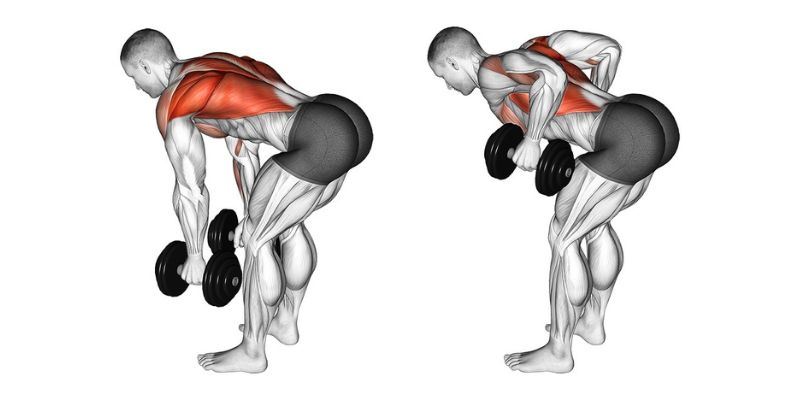
- Targets the lats, rhomboids, and rear deltoids for overall upper back development.
- How to: Bend at the waist, keeping your back straight. Pull the dumbbells towards your lower ribcage, squeezing your shoulder blades together.
- Tips: Focus on keeping your core engaged and avoid excessive swinging. Use a weight that allows for proper form.
- Sets & Reps: 3-4 sets of 8-12 reps.
Batwing Row
- Emphasizes scapular retraction and upper back activation, promoting better posture.
- How to: Lie facedown on an incline bench with dumbbells in hand. Row the dumbbells towards your ribcage, squeezing your shoulder blades together.
- Tips: Control the movement and avoid using momentum. Focus on the mind-muscle connection.
- Sets & Reps: 3 sets of 10-15 reps.
Unilateral Dumbbell Carry
- Challenges stability and core strength while engaging the upper back and shoulder stabilizers.
- How to: Hold a dumbbell in one hand and walk while keeping your torso upright and engaged.
- Tips: Keep your shoulders level and avoid leaning to one side. Choose a weight that challenges but allows for proper form.
- Sets & Reps: 2-3 sets of 30-60 seconds per side.
Unilateral Deadstop Row
- Enhances unilateral strength and stability, targeting each side of the back independently.
- How to: Set up as you would for a regular row. Pause the dumbbell on the ground between each rep.
- Tips: Maintain a stable core and avoid rotating your torso. Focus on driving your elbow back and squeezing your shoulder blades.
- Sets & Reps: 3 sets of 8-10 reps per side.
Seal Row
- Isolates the back muscles by eliminating lower body involvement, promoting strict form and muscle engagement.
- How to: Lie face down on a flat bench with dumbbells hanging below. Row the dumbbells towards your ribcage, retracting your shoulder blades.
- Tips: Keep your chest pressed against the bench throughout the movement. Focus on the squeeze at the top.
- Sets & Reps: 3-4 sets of 10-12 reps.
Chest-Supported Row
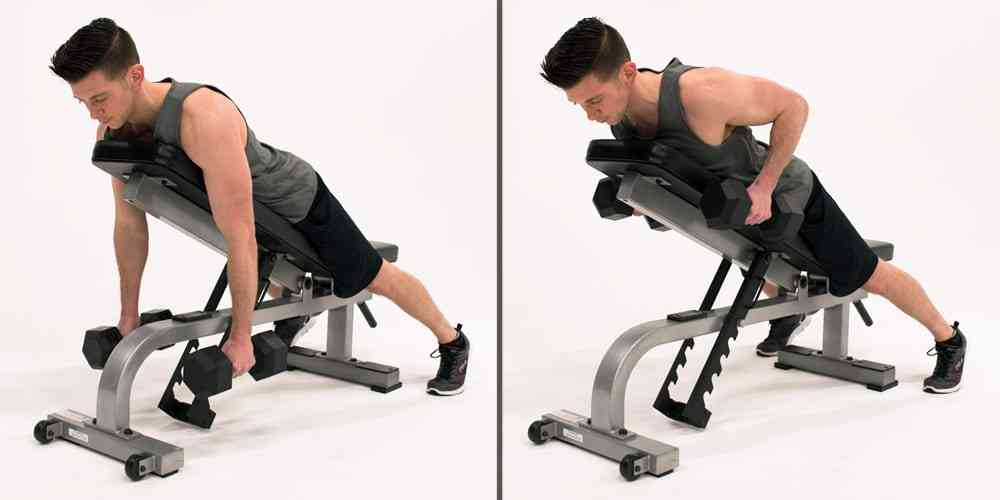
- Minimizes lower back involvement, allowing for strict focus on upper back muscles.
- How to: Lie face down on an incline bench with dumbbells in hand. Row the dumbbells towards your ribcage, keeping elbows close to the body.
- Tips: Maintain a neutral spine and avoid arching your back. Squeeze your shoulder blades together at the top.
- Sets & Reps: 3 sets of 8-12 reps.
RDL Row (Romanian Deadlift Row)
- Combines the benefits of a Romanian deadlift with a row, targeting the hamstrings, glutes, and upper back.
- How to: Perform a Romanian deadlift, then row the dumbbells towards your ribcage while keeping your back straight.
- Tips: Focus on hinging at the hips and keeping your core engaged. Avoid rounding your back during the row.
- Sets & Reps: 3 sets of 8-10 reps.
Stability Bent Over Dumbbell Rear Delt Raise
- Targets the rear deltoids and improves shoulder stability and posture.
- How to: Bend forward at the waist with a slight bend in the knees. Raise the dumbbells to the sides, keeping your arms straight.
- Tips: Keep your chest up and shoulder blades pulled back. Control the movement and avoid swinging.
- Sets & Reps: 3 sets of 12-15 reps.
Dumbbell Row To Hip
- Focuses on the lower portion of the back muscles, including the lats and lower traps.
- How to: Perform a regular dumbbell row, but instead of pulling towards the ribcage, row the dumbbells towards your hips.
- Tips: Keep your elbows close to your body and squeeze your shoulder blades at the top. Control the descent of the dumbbells.
- Sets & Reps: 3 sets of 10-12 reps.
Dumbbell Pullover
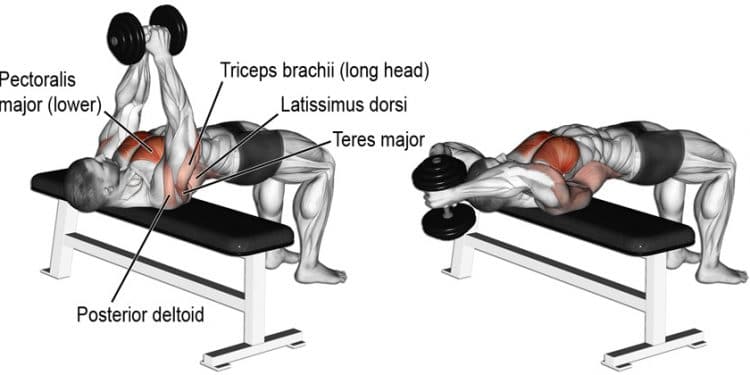
- Engages the lats, chest, and triceps while stretching the ribcage and promoting thoracic extension.
- How to: Lie on a bench with only your upper back and shoulders supported. Hold a dumbbell overhead, then lower it behind your head while keeping your arms slightly bent.
- Tips: Keep your core engaged and maintain a slight bend in your elbows throughout the movement. Avoid arching your lower back excessively.
- Sets & Reps: 3 sets of 10-12 reps.
Chest Supported Touch Row
- Provides stability and isolates the upper back muscles for targeted development.
- How to: Lie face down on an incline bench with dumbbells in hand. Row the dumbbells towards your ribcage, touching the bench with each rep.
- Tips: Maintain a neutral spine and avoid excessive swinging. Focus on the squeeze at the top of the movement.
- Sets & Reps: 3 sets of 10-12 reps.
Man-maker
- A full-body exercise that combines a variety of movements, including rows, push-ups, and presses.
- How to: Begin in a plank position with dumbbells in hand. Perform a push-up, then row each dumbbell, followed by a squat and overhead press.
- Tips: Keep your core engaged and maintain proper form throughout each movement. Start with light weights and focus on mastering the technique.
- Sets & Reps: 3 sets of 6-8 reps.
W-raise
- Targets the rear deltoids and promotes scapular retraction for improved posture.
- How to: Stand with dumbbells in hand, arms extended in front of you. Raise the dumbbells out to the sides in a W shape, squeezing your shoulder blades together.
- Tips: Keep a slight bend in your elbows and focus on leading with your elbows. Control the movement and avoid swinging.
- Sets & Reps: 3 sets of 12-15 reps.
Bench Reverse Hyper
- Isolates the lower back and glutes, providing support for overall back health.
- How to: Lie face down on a bench with your hips at the edge. Hold onto the bench for stability and raise your legs towards the ceiling.
- Tips: Keep your core engaged and maintain control throughout the movement. Avoid hyperextending your lower back.
- Sets & Reps: 3 sets of 12-15 reps.
Muscle Growth with Functional Workouts
By incorporating these exercises into your upper back workout routine and following the recommended sets, reps, and tips, you can effectively target and strengthen your upper back muscles with dumbbells.
Progression Tips
Progressing over time is crucial for continuously challenging your muscles and achieving your fitness goals. Here are some effective strategies for progressing in your upper back workouts with dumbbells:
- Increase Weight Gradually: As you become stronger, gradually increase the weight of your dumbbells to continue challenging your muscles. Aim for a weight that allows you to perform the desired number of repetitions with proper form, but that also pushes you to near fatigue by the end of the set.
- Add Sets and Repetitions: Another way to progress is by adding additional sets or repetitions to your exercises. For example, if you’ve been performing three sets of 10 repetitions for a particular exercise, try increasing it to four sets or increasing the number of repetitions to 12-15.
- Decrease Rest Time: Shortening the rest intervals between sets can increase the intensity of your workouts and help improve your muscular endurance. Gradually reduce rest times between sets from 60 seconds to 45 seconds or even 30 seconds as your fitness level improves.
- Focus on Form and Range of Motion: Pay close attention to your form and range of motion during each exercise. As you become more proficient, aim to perform each movement with a stricter form and a fuller range of motion, which can help activate more muscle fibers and enhance results.
- Try Advanced Variations: Once you’ve mastered the basic dumbbell exercises for the upper back, consider incorporating more advanced variations to further challenge yourself. This could include exercises like single-arm dumbbell rows, renegade rows, or weighted pull-ups if you have access to a pull-up bar.
- Utilize Tempo Training: Experiment with different tempos during your exercises to vary the time under tension for your muscles. For example, try slowing down the eccentric (lowering) phase of the movement or pausing at the peak contraction to increase the difficulty and stimulate muscle growth.
- Incorporate Progressive Overload: Progressive overload is the principle of gradually increasing the stress placed on the muscles over time to stimulate adaptation and growth. This can be achieved through any combination of increasing weight, volume, intensity, or frequency of your workouts.
- Periodize Your Training: Consider implementing a periodization plan where you cycle through phases of varying intensity and volume over a set period of time, such as several weeks or months. This structured approach can help prevent plateaus and optimize long-term progress.
Remember, progression should be at a pace that’s comfortable for you and allows your body to adapt without the risk of injury.
Common Mistakes
When performing upper back exercises with dumbbells, it’s important to be aware of common mistakes that can lead to ineffective workouts or even injuries. Here are some errors to avoid:
- Bent Wrists: Holding dumbbells with bent wrists can lead to wrist strain and reduce the effectiveness of the exercise. Keep your wrists straight and aligned with your forearms.
- Using Momentum: Relying on momentum rather than muscle strength to lift the weights can compromise form and reduce muscle engagement. Ensure you’re lifting with control, especially during movements like bicep curls and shoulder presses.
- Improper Rowing Technique: Common mistakes in dumbbell rows include shrugging the shoulders, rotating the torso excessively, and letting the elbow flare out too wide. These errors can lead to overactive traps and underactive lats, and potentially cause shoulder injuries.
- Rounded Back: A rounded back during exercises like the bent-over row can put unnecessary stress on the lower back. Maintain a neutral spine with a slight natural arch to protect your back.
- Limited Range of Motion: Not moving through the full range of motion can limit the development of your upper back muscles. Make sure to extend and contract your muscles fully during each repetition.
- Not Controlling the Return: Letting the weights drop quickly after the lift phase can lead to muscle strain. Control the weight throughout the entire movement, including the return to the starting position.
- Losing Grip: A weak grip can lead to a loss of control over the dumbbells. Strengthen your grip and ensure it’s secure before starting your sets.
Comparing Front and Back Squats
By avoiding these common errors, you can ensure a safer and more effective workout for your upper back. Always focus on maintaining proper form and gradually increasing the intensity of your workouts as you progress.
FAQs
Q 1. What weight of dumbbells should I start with for upper back exercises?
Ans. If you’re a beginner, it’s best to start with lighter weights that allow you to perform the exercises with proper form. As you get stronger, you can gradually increase the weight.
Q 2. How often should I do these dumbbell back exercises?
Ans. It’s generally recommended to train each muscle group 2-3 times per week. However, the exact frequency can vary depending on your overall fitness level and goals.
Q 3. Can I still get a good back workout if I only have one dumbbell?
Ans. Absolutely! Many of the exercises mentioned can be performed unilaterally, meaning you work one side of your body at a time. This can actually help improve muscle imbalances.
Q 4. I’m feeling pain in my lower back during these exercises. What could be the reason?
Ans. Lower back pain during these exercises could be a sign of poor form or a pre-existing condition. It’s important to ensure you’re performing the exercises correctly. If the pain persists, please consult a healthcare professional.
Q 5. What can I do if I don’t have access to dumbbells? Are there alternative equipment I can use?
Ans. Yes, you can use resistance bands, kettlebells, or even household items like water bottles or canned goods as alternatives to dumbbells.
Q 6. Are these exercises safe for people with back problems?
Ans. While these exercises are generally safe, anyone with back problems should consult with a healthcare provider before starting any new exercise regimen.
Q 7. What should I do if I don’t feel the burn in my back muscles during these exercises?
Ans. Not feeling the burn could be a sign that you’re not engaging the correct muscles or that the weight you’re using is too light. Try to focus on the muscle you’re working and consider increasing the weight if you’re not feeling challenged.
Conclusion
In summary, targeting the upper back with dumbbell exercises is a powerful way to enhance posture, increase strength, and improve overall health. We’ve explored the anatomy of the upper back, the benefits of strengthening it, and a variety of exercises suitable for all fitness levels. Remember, progression is about consistency and gradual increases in intensity. Avoid common mistakes by focusing on proper form and technique, and don’t forget the pivotal role of nutrition and recovery in your fitness journey.
As you incorporate these exercises into your routine, listen to your body and adjust as needed. Whether you’re just starting out or are looking to intensify your workouts, the path to a stronger upper back is clear. Keep pushing your limits, and you’ll not only see the difference but feel it in every aspect of your daily life.

Good day, and welcome to Fitthour. My name is Shubham Vijay, and I am a certified personal trainer and nutrition coach with 6 years of experience in the fitness industry. At Fitthour, we specialize in types of training, such as strength training, cardio, or HIIT, and our mission is to help clients achieve their fitness goals and improve their overall health.

